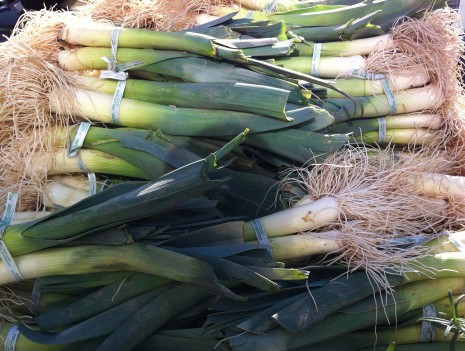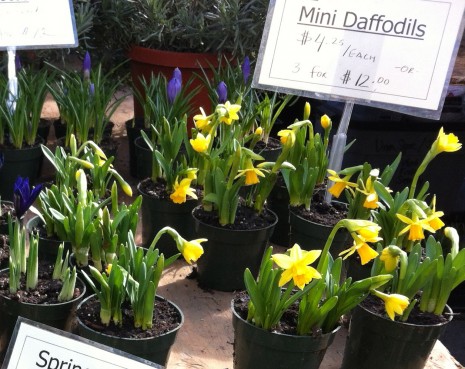LEEKS—FROM MARKET TO MESOPOTAMIA AND BACK
Leeks are a slow-growing crop; the beauts you see here were planted last summer. They’re as stalwart and noble as whoever is outside this time of year, digging them out of the frozen ground. I bought plenty—enough for a pot of leek and potato soup and then some.
Beneath that rugged appearance, you see, the leek is a big ol’ softy; when cooked, it turns delicate and complex in flavor and lush, almost velvety, in texture. And once you stop thinking of this vegetable as an aromatic seasoning and grant it a bigger role in the kitchen, you’ll feel as though you have discovered a whole new vegetable.
It’s so versatile, in fact, it took me forever to decide what to do with the rest of my haul. Leeks are always delicious gently cooked in butter and served with scallops, with a little crisp bacon crumbled over. Creamed or in a gratin, they’re awfully good with ham or steak. Belgium is famous for the mashed potato and leek combo called Stoemp met Prei as well as flamiche, or leek and goat cheese tart. I had leeks in the Middle East with a yogurt sauce, and leeks à la Grecque—that is, simmered with coriander seeds, bay leaves, red wine, and honey—has been around since the days of Homer. Talk about a classic!
And how. The leek probably originated in the Mediterranean, although it’s so old, no one really knows for sure. It’s frequently mentioned, however, along with garlic and onions, in the Yale culinary tablets, three compact Mesopotamian clay slabs that date from circa 1750 B.C. They contain what are probably the oldest known recipes—about 40 in all and including rich, sophisticated preparations for stag, gazelle, mutton, partridges, “wildfowl pie,” and grain pilafs—written in tiny cuneiform script and listing ingredients in order of use. And we think we’re so smart.
The first known Roman cookbook, commonly referred to as “Apicius” and compiled in the late fourth or early fifth century A.D., snubs garlic and onions, but contains leek recipes; you’ll find all sorts of delicious treatments in today’s Italian cookbooks as well. Since I spent so much time dithering over (and getting lost in) cookbooks, in the end I opted for Marcella Hazan’s simple braise embellished with some grated Parmigiano—easy to do on the stovetop while a chicken stuffed with rosemary and garlic was roasting away in the oven.
Shopping & cleaning notes: Look for leeks with a long white and pale-green stem, or stalk. That’s the edible part, and the longer it is, the greater your yield will be. I’ll use the dark-green leaves in chicken or vegetable stock, and the tattered top, or “flag,” would go in a compost pail if I were a better person. Instead it goes in the trash. The stem is actually a bundle of tightly bound leaves; the reason leeks always have a certain amount of soil embedded in those layers is because of how they grow. Any soil on the leaves is eventually washed down to where the stem begins; it works its way deeper into the plants as they mature, which is why you need to wash them so thoroughly.
Braised Leeks with Parmesan Cheese
Adapted from Marcella Hazan’s Essentials of Classic Italian Cooking (Alfred A. Knopf, 1992)
Serves 4
4 large or 6 medium leeks (white and pale-green parts only)
3 tablespoons butter, cut into pieces
Coarse salt
A splash of dry white wine
3 tablespoons freshly grated Parmigiano-Reggiano
1. Cut each leek lengthwise in two. Wash the leeks very thoroughly under cold running water, spreading the layers of leaves with your hands and rubbing them to make sure any hidden bits of soil are washed away. Swish them around in a bowl of cold water, just to make sure.
2. Put the leeks in a pan just broad and long enough so that they can lie flat and straight on their cut sides. Add the butter, a scattering of salt, the wine, and enough water to cover. Put a lid on the pan and cook over medium-low heat until thickest part of the leeks feels tender with prodded with a fork, 15 to 25 minutes. Turn them from time to time while they cook.
3. When done, uncover the pan, turn the heat up to high, and boil away all the watery juices in the pan. In the process, the leeks should become lightly browned. Before removing from the heat, add the grated Parmesan, turn the leeks over once or twice, then transfer to a warm platter and serve at once.
By the way, the Romans brought leeks into Britain, where they remain a treasured component of kitchen gardens; the vegetable, in fact, is an emblem of Wales, along with the daffodil. Reason alone to make room in your market basket for those, too.
Posted: March 19th, 2013 under cookbooks, cooking, culinary history, early spring, recipes.




Pingback from A SPRING LEEK GRATIN | Jane Lear. Writing on Food and Travel.
Time May 19, 2015 at 6:09 pm
[…] turn lush when cooked. You can get a good idea about how I like to use them (and then some) from this post from 2013. But this year I’m happily stuck on leek […]